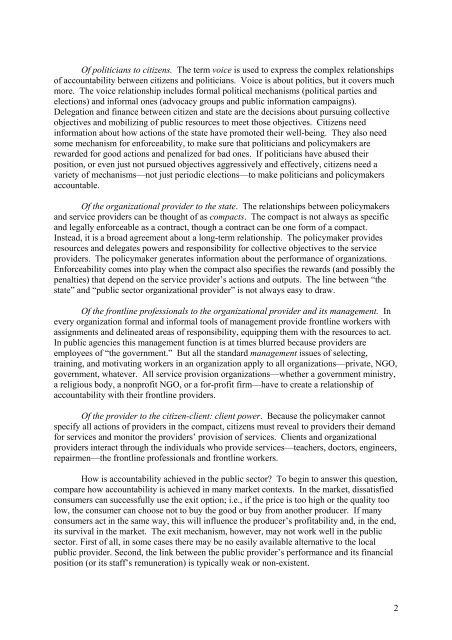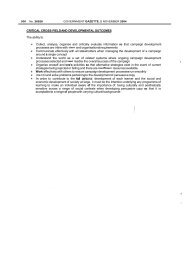Citizen Report Cards to Improve Service Delivery - South Africa ...
Citizen Report Cards to Improve Service Delivery - South Africa ...
Citizen Report Cards to Improve Service Delivery - South Africa ...
You also want an ePaper? Increase the reach of your titles
YUMPU automatically turns print PDFs into web optimized ePapers that Google loves.
Of politicians <strong>to</strong> citizens. The term voice is used <strong>to</strong> express the complex relationships<br />
of accountability between citizens and politicians. Voice is about politics, but it covers much<br />
more. The voice relationship includes formal political mechanisms (political parties and<br />
elections) and informal ones (advocacy groups and public information campaigns).<br />
Delegation and finance between citizen and state are the decisions about pursuing collective<br />
objectives and mobilizing of public resources <strong>to</strong> meet those objectives. <strong>Citizen</strong>s need<br />
information about how actions of the state have promoted their well-being. They also need<br />
some mechanism for enforceability, <strong>to</strong> make sure that politicians and policymakers are<br />
rewarded for good actions and penalized for bad ones. If politicians have abused their<br />
position, or even just not pursued objectives aggressively and effectively, citizens need a<br />
variety of mechanisms—not just periodic elections—<strong>to</strong> make politicians and policymakers<br />
accountable.<br />
Of the organizational provider <strong>to</strong> the state. The relationships between policymakers<br />
and service providers can be thought of as compacts. The compact is not always as specific<br />
and legally enforceable as a contract, though a contract can be one form of a compact.<br />
Instead, it is a broad agreement about a long-term relationship. The policymaker provides<br />
resources and delegates powers and responsibility for collective objectives <strong>to</strong> the service<br />
providers. The policymaker generates information about the performance of organizations.<br />
Enforceability comes in<strong>to</strong> play when the compact also specifies the rewards (and possibly the<br />
penalties) that depend on the service provider’s actions and outputs. The line between “the<br />
state” and “public sec<strong>to</strong>r organizational provider” is not always easy <strong>to</strong> draw.<br />
Of the frontline professionals <strong>to</strong> the organizational provider and its management. In<br />
every organization formal and informal <strong>to</strong>ols of management provide frontline workers with<br />
assignments and delineated areas of responsibility, equipping them with the resources <strong>to</strong> act.<br />
In public agencies this management function is at times blurred because providers are<br />
employees of “the government.” But all the standard management issues of selecting,<br />
training, and motivating workers in an organization apply <strong>to</strong> all organizations—private, NGO,<br />
government, whatever. All service provision organizations—whether a government ministry,<br />
a religious body, a nonprofit NGO, or a for-profit firm—have <strong>to</strong> create a relationship of<br />
accountability with their frontline providers.<br />
Of the provider <strong>to</strong> the citizen-client: client power. Because the policymaker cannot<br />
specify all actions of providers in the compact, citizens must reveal <strong>to</strong> providers their demand<br />
for services and moni<strong>to</strong>r the providers’ provision of services. Clients and organizational<br />
providers interact through the individuals who provide services—teachers, doc<strong>to</strong>rs, engineers,<br />
repairmen—the frontline professionals and frontline workers.<br />
How is accountability achieved in the public sec<strong>to</strong>r? To begin <strong>to</strong> answer this question,<br />
compare how accountability is achieved in many market contexts. In the market, dissatisfied<br />
consumers can successfully use the exit option; i.e., if the price is <strong>to</strong>o high or the quality <strong>to</strong>o<br />
low, the consumer can choose not <strong>to</strong> buy the good or buy from another producer. If many<br />
consumers act in the same way, this will influence the producer’s profitability and, in the end,<br />
its survival in the market. The exit mechanism, however, may not work well in the public<br />
sec<strong>to</strong>r. First of all, in some cases there may be no easily available alternative <strong>to</strong> the local<br />
public provider. Second, the link between the public provider’s performance and its financial<br />
position (or its staff’s remuneration) is typically weak or non-existent.<br />
2
















